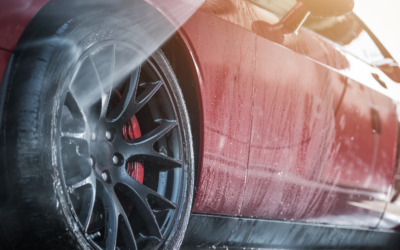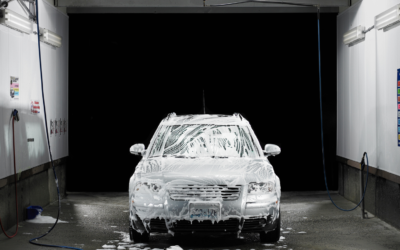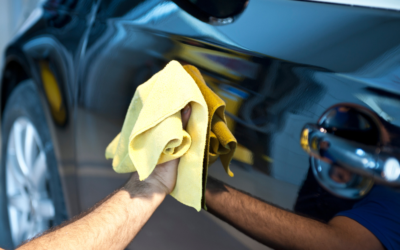Salt, grime, and road debris accumulate beneath your car every time you drive. While most drivers focus on keeping their vehicle’s exterior spotless, the undercarriage often gets neglected—a costly mistake that can lead to rust, corrosion, and expensive repairs down the road.
An undercarriage car wash removes harmful contaminants from the underside of your vehicle, protecting critical components like the exhaust system, brake lines, and suspension parts. This comprehensive cleaning process extends your car’s lifespan and maintains its resale value by preventing damage that occurs when salt, mud, and debris are left to sit on metal surfaces.
Whether you’re dealing with winter road salt, muddy off-road adventures, or simply want to maintain your vehicle properly, understanding how undercarriage cleaning works will help you make informed decisions about your car care routine. This guide covers everything from the cleaning process itself to DIY methods and professional services.
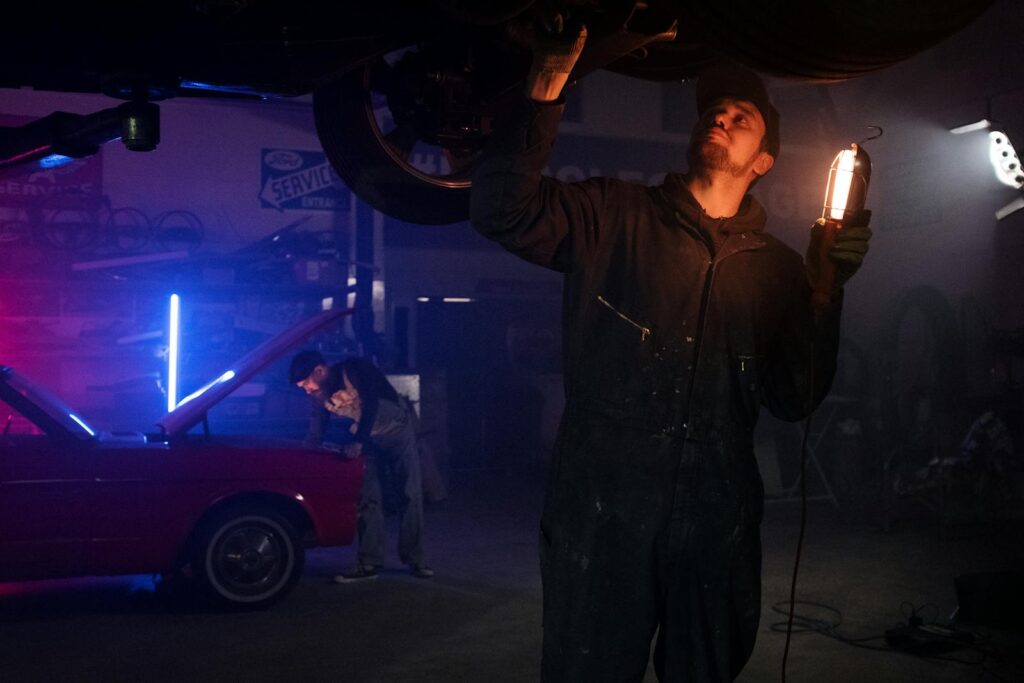
Photo by cottonbro studio on Pexels
What Is an Undercarriage Car Wash?
An undercarriage car wash is a specialized cleaning process that targets the underside of your vehicle, removing accumulated dirt, salt, mud, and other debris that regular exterior washing can’t reach. This service focuses specifically on the components beneath your car that are constantly exposed to road conditions but rarely receive attention during routine cleaning.
The undercarriage includes critical vehicle systems like the exhaust, brake lines, suspension components, and the frame itself. These parts face constant exposure to moisture, salt, and debris, making them particularly vulnerable to corrosion and damage over time.
Most car washes offer undercarriage cleaning as either a standalone service or as part of their premium wash packages. The process typically involves high-pressure water jets positioned beneath the vehicle that spray upward, dislodging contaminants from hard-to-reach areas.
Why Your Car’s Undercarriage Needs Special Attention
Road salt poses the greatest threat to your vehicle’s undercarriage. During winter months, municipalities spread salt and chemical de-icers on roads to prevent ice formation. While effective for road safety, these substances are highly corrosive to metal components.
Salt accelerates the oxidation process, causing rust to form much faster than it would under normal conditions. Once rust takes hold, it spreads rapidly, weakening structural components and potentially compromising safety systems.
Beyond salt damage, the undercarriage collects mud, gravel, and organic debris that retains moisture against metal surfaces. This creates an environment where corrosion thrives, especially in areas where drainage is poor or air circulation is limited.
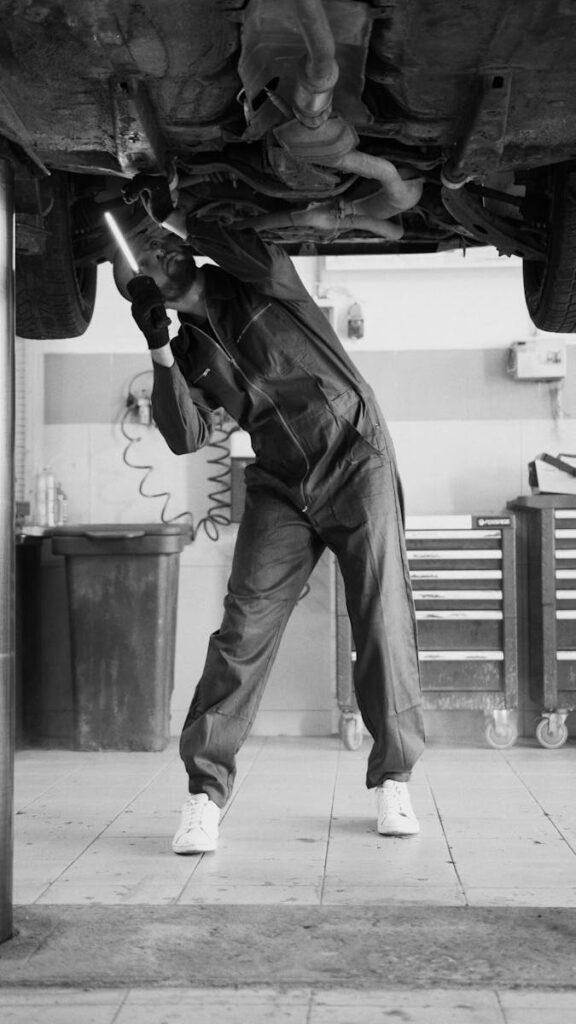
Photo by Artem Podrez on Pexels
The Undercarriage Cleaning Process Explained
Professional undercarriage cleaning follows a systematic approach designed to remove contaminants effectively while protecting sensitive components. Understanding this process helps you evaluate different service options and determine what your vehicle needs.
Pre-Wash Inspection and Preparation
Before beginning the cleaning process, technicians typically inspect the undercarriage for existing damage, loose components, or areas requiring special attention. This inspection identifies potential issues that could worsen during high-pressure washing.
The vehicle is positioned over specialized wash bays equipped with undercarriage spray systems. These systems feature multiple high-pressure nozzles strategically positioned to reach all areas beneath the car, much like the Mercedes Car Wash Mode enhances undercarriage cleaning and protection.
High-Pressure Water Application
The cleaning process begins with high-pressure water application to remove loose dirt and debris. Water temperature varies depending on the service level, with warm water proving more effective at dissolving salt residue and breaking down stubborn grime.
Pressure washers used for undercarriage cleaning typically operate at higher pressures than standard garden hose attachments, ensuring thorough removal of accumulated contaminants. The spray pattern covers the entire underside, including wheel wells, suspension components, and the exhaust system.
Specialized Cleaning Solutions
Many professional services apply specialized cleaning solutions designed to neutralize road salt and break down organic debris. These solutions are formulated to be effective against corrosive substances while remaining safe for vehicle components and the environment.
The cleaning solution is allowed to dwell on surfaces for a specified time, allowing it to penetrate and dissolve stubborn deposits that water alone cannot remove.
Final Rinse and Inspection
After the cleaning solution has done its work, technicians perform a thorough rinse with clean water to remove all traces of cleaning chemicals and loosened debris. This final rinse ensures no residue remains that could attract dirt or cause future corrosion.
A post-cleaning inspection verifies that all areas have been properly cleaned and identifies any components that may need additional attention or repairs.
DIY Undercarriage Washing: Tools and Techniques
While professional undercarriage cleaning offers the most thorough results, car owners can perform basic undercarriage maintenance at home with the right tools and techniques.
Essential Equipment for Home Undercarriage Cleaning
A pressure washer provides the most effective cleaning power for DIY undercarriage washing. Look for units capable of producing at least 1500 PSI, though higher pressure ratings offer better cleaning performance.
If a pressure washer isn’t available, a garden hose with a high-pressure nozzle attachment can provide adequate cleaning for light maintenance. However, garden hose pressure typically isn’t sufficient for removing heavy salt buildup or compacted mud.
An undercarriage spray attachment extends your reach beneath the vehicle, allowing you to clean areas that would otherwise be inaccessible. These attachments connect to pressure washers or garden hoses and feature angled nozzles designed for undercarriage cleaning.
Step-by-Step DIY Cleaning Process
Begin by positioning your vehicle on level ground where water runoff won’t cause problems. Avoid washing over grass or garden areas if you’ve driven on salted roads recently, as salt-contaminated runoff can damage vegetation.
Start the cleaning process by rinsing the undercarriage with clean water to remove loose dirt and debris. Work systematically from front to back, ensuring complete coverage of all accessible areas.
Pay special attention to wheel wells, which tend to collect the most debris and are often overlooked during regular washing. Use the spray wand to flush out accumulated mud and debris from these areas.
Focus on areas where components create pockets or crevices where debris can collect. These include suspension mounting points, exhaust heat shields, and frame rails where moisture and contaminants tend to accumulate.
Safety Considerations for DIY Cleaning
Never position yourself directly beneath a vehicle supported only by a jack. If you need to access the undercarriage for detailed cleaning, use proper jack stands and follow all safety protocols.
Be cautious when using high-pressure water around electrical components, sensors, and sealed bearings. While these components are designed to withstand moisture, excessive pressure can force water into areas where it doesn’t belong.
Wear appropriate safety equipment, including eye protection and waterproof clothing. High-pressure spray can cause debris to fly unpredictably, creating potential safety hazards.
Professional vs. DIY: Making the Right Choice
The decision between professional undercarriage cleaning and DIY maintenance depends on several factors, including your vehicle’s exposure to harsh conditions, available equipment, and personal comfort level with automotive maintenance.
Advantages of Professional Undercarriage Cleaning
Professional car wash facilities have specialized equipment designed specifically for undercarriage cleaning. Their systems provide consistent pressure and coverage that’s difficult to achieve with consumer-grade equipment.
Experienced technicians understand which areas require special attention and can identify potential problems during the cleaning process. They’re trained to recognize signs of damage or wear that might indicate the need for repairs.
Many professional services offer packages that combine undercarriage cleaning with other protective treatments, providing comprehensive vehicle care in a single visit.
When DIY Cleaning Makes Sense
Regular maintenance cleaning can be effectively performed at home, especially for vehicles that haven’t been exposed to heavy salt or extreme conditions. DIY cleaning works well for removing light accumulations of dirt and debris.
Car enthusiasts who enjoy maintaining their vehicles often prefer the hands-on approach of DIY cleaning. This allows for detailed inspection of components and personalized attention to problem areas.
Cost considerations may favor DIY cleaning for owners of multiple vehicles or those who prefer to handle their own maintenance tasks.
Combining Professional and DIY Approaches
Many car owners find success in combining both approaches, using professional services for thorough seasonal cleaning while performing regular maintenance washing at home.
This hybrid approach provides the deep cleaning benefits of professional equipment while maintaining ongoing protection through regular DIY maintenance.
Preventing Undercarriage Damage: Best Practices
Prevention remains the most effective strategy for protecting your vehicle’s undercarriage from damage. Understanding how to minimize exposure to harmful contaminants and implementing regular maintenance routines can significantly extend your vehicle’s lifespan.
Seasonal Maintenance Scheduling
Winter presents the greatest challenge for undercarriage protection due to road salt and de-icing chemicals. Plan for more frequent undercarriage cleaning during winter months, ideally every two to four weeks depending on driving conditions.
Spring cleaning becomes crucial as temperatures rise and accumulated salt begins to activate with increased moisture. A thorough undercarriage cleaning at the end of winter removes salt deposits before they can cause significant damage.
Summer and fall maintenance focuses on removing mud, debris, and organic matter that can retain moisture against metal surfaces.
Protective Measures and Products To Prevent Rust
Undercoating and rust prevention products provide an additional layer of protection for the undercarriage. These products create a barrier between metal surfaces and corrosive substances, significantly extending component life.
Some car owners apply wax or protective coatings to accessible undercarriage components, though these treatments require reapplication and may not be practical for all areas.
Regular inspection of the undercarriage allows for early detection of problems before they become serious. Look for signs of rust, damage to protective coatings, or accumulation of debris that could trap moisture.
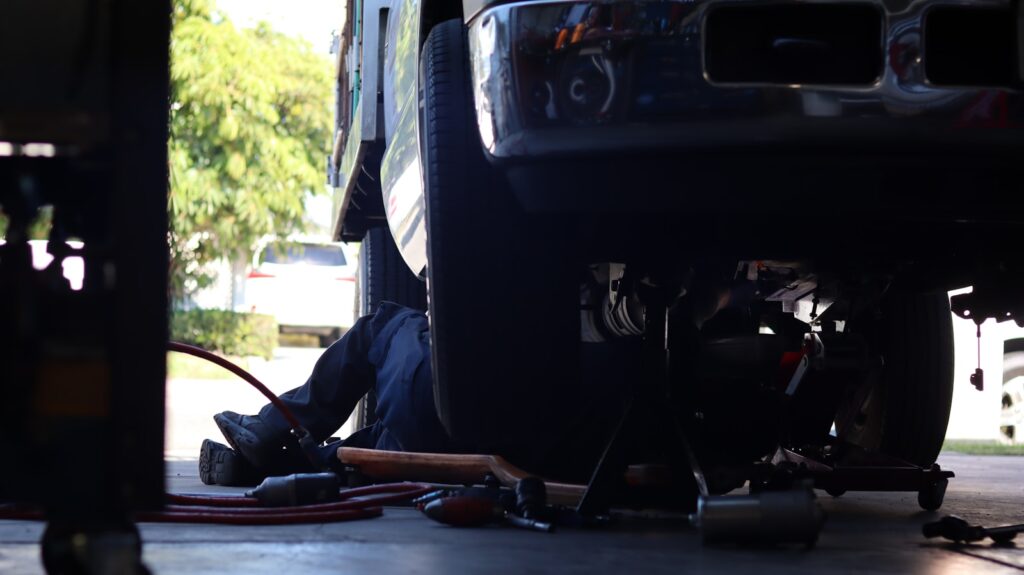
Photo by Danny Pineda on Unsplash
Products for Cleaning Your Car’s Undercarriage
To achieve the best results when cleaning your car’s undercarriage, it’s crucial to choose high-quality products. Here are six top-rated tools and cleaners, along with links to their respective websites for purchase:
Chemical Guys Heavy Duty Degreaser
This powerful degreaser is perfect for breaking down grease, grime, and road salt on your undercarriage. It’s trusted by professionals and DIY car enthusiasts alike.
Karcher Pressure Washer Undercarriage Cleaner Attachment
Designed to work with most Karcher pressure washers, this attachment makes cleaning your undercarriage easy and efficient by spraying at the perfect angle.
Citrus-based Undercarriage Cleaner by Adam’s Polishes
If you’re looking for an eco-friendly option, Adam’s Polishes offers a citrus-based cleaner that effectively cuts through dirt while being safe for the environment.
Meguiar’s D108 Super Degreaser
This highly concentrated formula is perfect for tough grime and dirt buildup, providing a long-lasting clean for your car’s undercarriage. For tips on keeping your vehicle’s inside spotless, check out this ultimate guide to interior car cleaner.
Simple Green Pro HD Heavy-Duty Cleaner
A versatile cleaner suitable for a range of automotive applications, including undercarriages, Simple Green’s Pro HD formula is both effective and economical.
Each of these products and tools has been praised for its effectiveness and reliability, helping you achieve a spotless and well-maintained undercarriage.
Frequently Asked Questions
How often should I get an undercarriage car wash?
The frequency of undercarriage cleaning depends on your driving conditions and local climate. Vehicles exposed to road salt should receive undercarriage cleaning every 2-4 weeks during winter months. Cars driven primarily in mild conditions may need cleaning only monthly or seasonally.
Can I damage my car with high-pressure undercarriage washing?
When performed correctly, high-pressure undercarriage washing is safe for vehicles. However, excessive pressure directed at sensitive components like sensors, electrical connections, or sealed bearings can cause damage. Professional services use appropriate pressure levels and techniques to minimize risk.
Is undercarriage cleaning worth the extra cost?
Undercarriage cleaning provides significant long-term value by preventing rust and corrosion that can lead to expensive repairs. The cost of regular undercarriage maintenance is typically much less than replacing damaged components or dealing with structural rust issues.
What’s the difference between an undercarriage wash and an underbody flush?
These terms are often used interchangeably, though some facilities distinguish between basic rinsing (flush) and more thorough cleaning with specialized solutions (wash). Both services target the same area but may differ in intensity and thoroughness.
Can I use soap or detergent for DIY undercarriage cleaning?
While water alone removes many contaminants, specialized undercarriage cleaning solutions are more effective against road salt and stubborn deposits. Avoid using harsh detergents that might damage rubber components or protective coatings.
Protecting Your Investment Through Proper Care
Your vehicle represents a significant investment that deserves protection from the ground up. Undercarriage cleaning plays a crucial role in maintaining your car’s structural integrity, safety systems, and resale value.
Regular undercarriage maintenance prevents costly repairs and extends vehicle life, making it one of the most cost-effective services you can provide for your car. Whether you choose professional services, DIY maintenance, or a combination of both, consistent attention to your vehicle’s undercarriage pays dividends over time.
Start implementing undercarriage cleaning into your regular car care routine today. Your vehicle—and your wallet—will thank you for the extra attention to this often-overlooked but critically important aspect of automotive maintenance.



